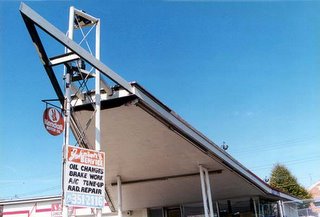 Chippewa & Macklind, South St. Louis, MO (in use)
Chippewa & Macklind, South St. Louis, MO (in use)
For several years, I’ve been fascinated with the bat-wing buildings found during travels. I once mentioned “finding another one,” and my father filled me in that those were formerly Phillips 66 gas stations. It was easy to figure the era of the buildings; there is none more mid-century car-centric than those bat wings.
 St. Charles Rock Road, St. John, MO (in use)
St. Charles Rock Road, St. John, MO (in use)
Having the Phillips 66 key did not help me track down any solid background information about the buildings. I was pretty much alone in my fascination for them, until my pal Darren Snow discovered my solitary hobby. He went through old St. Louis city and county directories from the early 1960s, and meticulously wrote down all Phillips 66 addresses. Much gas was used tracking down old gas stations.
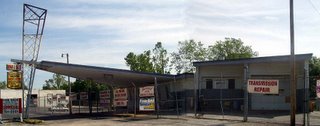 Lucas & Hunt Road, Velda Village, MO (in use)
Lucas & Hunt Road, Velda Village, MO (in use)
A few other like-minded folks were intrigued by my minor obsession, and began reporting back every time they found one. From East St. Louis to Hannibal, from Wisconsin to Indiana, the bat-wings were still out there. When not completely abandoned, they’re in use as some kind of car repair outfit. There’s no escaping the function of this very specific architecture.
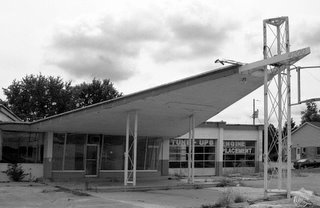 North Lindbergh @ Hwy 70, St. Ann, MO (demolished)
North Lindbergh @ Hwy 70, St. Ann, MO (demolished)
I amassed a lot of photos of a lot of remaining 66 Canopies. If I had limitless free time, I’d dig them all up for this narrative. If someone wants to pay me to do something useful with those photos, I’d plow through years of negatives and files. But this being the real world, we’ll stick with a smattering of Bat Wings.
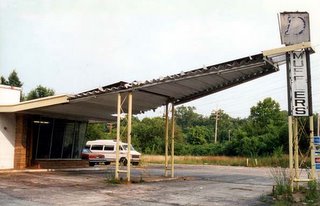 Old Halls Ferry Road, Moline Acres, MO (vacant)
Old Halls Ferry Road, Moline Acres, MO (vacant)
I learned to accept not knowing much of anything about the wings, other than what could be observed from all the specimens found. But it did seem odd that such a widely circulated, corporate-sponsored architecture was so woefully overlooked. Via Internet, I could see someone’s restaurant menu collection, but nothing on Phillips 66’s mid-century look? How absurd.
But everything changed come spring 2005…
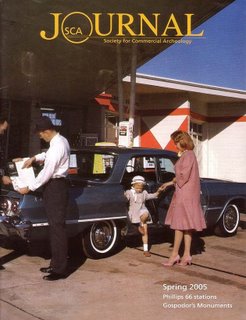 The Bat Wings landed on the cover of the Society for Commercial Archeology‘s magazine, with an 8-page article inside! The thrill of digesting writer Cliff Leppke’s detailed info on something that had long puzzled me was a dork’s delight… Gabba gabba we accept you, one of us, one of us!
The Bat Wings landed on the cover of the Society for Commercial Archeology‘s magazine, with an 8-page article inside! The thrill of digesting writer Cliff Leppke’s detailed info on something that had long puzzled me was a dork’s delight… Gabba gabba we accept you, one of us, one of us!
 To take financial advantage of the automobile revolution, Phillips 66 updated the look of their stations twice during the 1950s. Come 1960, they introduced “The New Look” of the “butterfly canopy,” a style they sold to station leaseholders as Harlequin. Designed by architect Clarence Reinhardt, “the canopy was a widely circulated symbol of architectural playfulness, (and) archival records indicate that Reinhardt was particularly inspired by early Los Angeles area drive-ins.”
To take financial advantage of the automobile revolution, Phillips 66 updated the look of their stations twice during the 1950s. Come 1960, they introduced “The New Look” of the “butterfly canopy,” a style they sold to station leaseholders as Harlequin. Designed by architect Clarence Reinhardt, “the canopy was a widely circulated symbol of architectural playfulness, (and) archival records indicate that Reinhardt was particularly inspired by early Los Angeles area drive-ins.”
 The wings were designed to point into heavy traffic and convey to motorists a “distinctive look of action, busyness… a spacious, more appealing appearance.” The “propulsion age air flow design” featured an abundance of fluorescent lighting because now more drivers were out at night, plus this safety feature – along with the new vibrant colors – would appeal to women drivers. The populuxe Harlequin 66 became ubiquitous in and around the new suburban frontiers, those post-WW2 cities that rapidly developed just outside a traditional big city’s borders.
The wings were designed to point into heavy traffic and convey to motorists a “distinctive look of action, busyness… a spacious, more appealing appearance.” The “propulsion age air flow design” featured an abundance of fluorescent lighting because now more drivers were out at night, plus this safety feature – along with the new vibrant colors – would appeal to women drivers. The populuxe Harlequin 66 became ubiquitous in and around the new suburban frontiers, those post-WW2 cities that rapidly developed just outside a traditional big city’s borders.
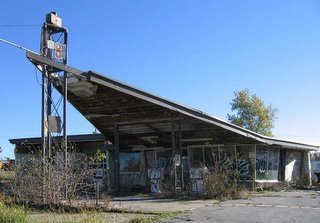 Highway 70 service road, Columbia, MO (vacant)
Highway 70 service road, Columbia, MO (vacant)
According to sociologists and Madison Avenue, America’s frenzied love affair with the automobile was more like a casual fling. “In 1968, Phillips began testing environmentally attuned ranch-style service stations. According to Phillips marketing engineer Cliff Sousa, ‘people’s attitudes about commercial architecture shifted.’ The gas station became a symbol not of progress but of what was wrong in American life.”
The arrival of the mobile home required taller canopies. The switch from full-service to self-service pumps required wider canopies to shelter consumers from the elements. “Phillips advised dealers to install mansard roofs on New Look stations, to repaint them with dark earthtone colors…” In less than a decade, the Phillips 66 look went from stiletto to earth shoe.
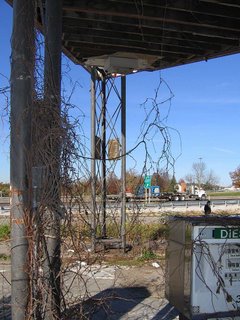 Once the 66 information damn burst, it became easier to find Bat Wing photos from across the nation. Roadside Architecture has a great page of Wings. The Kentucky Heritage Council put them in an Oblong Box category. What also emerges is a reverence for the double bat wing 66, and rightly so. Rock Hill, MO has just such an impressive creature, though the clock is ticking down to “time’s up.” That tale will be illustrated in Part 2.
Once the 66 information damn burst, it became easier to find Bat Wing photos from across the nation. Roadside Architecture has a great page of Wings. The Kentucky Heritage Council put them in an Oblong Box category. What also emerges is a reverence for the double bat wing 66, and rightly so. Rock Hill, MO has just such an impressive creature, though the clock is ticking down to “time’s up.” That tale will be illustrated in Part 2.
RELATED: Phillips 66, Part 2

The Phillips east of Columbia, MO is now demolished.
Thank you for sharing! I am working on a project in Houston titled “Houston: Uncommon Modern” documenting everyday buildings of the mid-century and vernacular architecture of the time. We have found at least 5 of these stations in the greater Houston area. I’m happy to share pics.
Great Blog!!!
I just became interested in these “Batwing” stations recently. I was watching a youtube video featuring the Belmonts. The video showed “old” hangouts from the 1950’s and 60’s. Then, there was a brief image showing the Phillips 66 Map and on the next picture it showed the “same” station in present time, with pumps shut off abandoned and alone in the middle of nowhere. It had the Phillips design on the right side of the building with 2 bay doors. I would be willing to contribute to your cause of finding your old negatives and photos. Especially, if you help me locate the Station I am looking to find. Thank you for the history and great pictures of my newest hobby.
Nick
What a great blog! Enjoyed learning more about the Phillips stations.
I may have to update some of my descriptions. I have photographed about 8 such stations in Kansas City.
I thought you might be interested in this Burlington, Vermont Bat Wing that I restored into a restaurant.
http://www.thespotvt.com/photos/open/
I alway thought that these style stations were Sunoco Stations, I guess i have the answer here. I see one this style in Lowell, Ma. I guess it’s was Phillips.
God, I love this stuff. One day they shut it doen and left it,. All the weeds, and Vines. The pumps are old as well…They look analog( Is that what you call it)
Toby-
I have a special affection for the last station here, the one outside of Columbia along old Hwy. 40. I surveyed that building a couple of years ago when I was working for MoDOT on an architectural survey along the I-70 corridor. Of course it isn’t national register eligible- well, not yet- so MoDOT wasn’t too interested in it. And based on the survey guidelines they set up for this particular survey, we weren’t supposed to research anything post-1945. So despite how beautiful I think it is, I didn’t even get a chance to find the building permit for it. And if in the future they get to widen I-70 like they want to, then it will be gone as well.
There’s another really awesome 1960s gas station in Kingdom City just north of I-70. Not a bat-wing, but equally cool I think.
I know I’ve seen another bat-wing in north city that I don’t see here, but I can’t remember its location. North Grand maybe? Anyway, I think it is a BBQ place now. Someone with a better knowledge of the northside might know where it is.